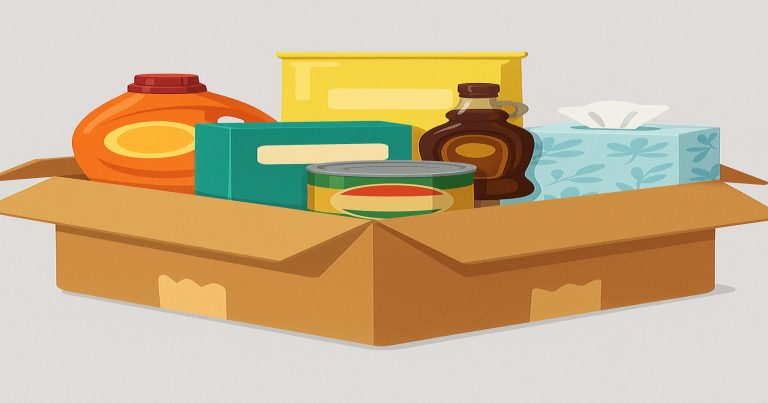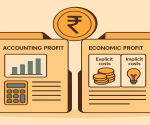Final goods are the last stage of an economic analysis, and as a culmination of the end of the production process, constitute a direct indicator of consumption demand. In contrast to intermediate goods used as inputs to produce further items, final goods are ready for consumption or investment by the end user. Their production and consumption provide significant insight into a country’s economy and the functioning of its markets. When approaching concepts such as national income and Gross Domestic Product (GDP) measurement, knowing what constitutes a final good is essential. Studying economics and running a business benefits from understanding the nature of a final good versus an intermediate good for accurate reporting, investment planning and policy formation purposes.
What Are Final Goods?
Final goods refer to those products and services that have completed all stages of production and are available for consumers or businesses without further transformation. These goods are not intended to produce other goods or services. Instead, they are consumed or used for their intended purposes. This concept helps economists separate actual consumer demand from production processes. Final goods include tangible items like furniture, clothes, and food and intangible services like education, banking, and entertainment. They are crucial for analysing the real output of an economy.

Goods for End-Consumption
Such consumables include food, clothing, and communication equipment. They fulfil the consumer’s basic needs without undergoing any further processing. Such goods are manifestations of customer behaviour tendencies and market needs. The volumes sold are essential indicators of retailing and service performance across economic cycles.
Final Goods Capital Goods
A machine or building made by a producer for long-term use but not for sale by an organisation is regarded as a final product for the calculation of GDP. Such goods are termed investment goods. They increase the economy’s productive capacity, ultimately affecting long-term growth and innovation, especially in construction, energy, and manufacturing.
Durable vs. Non-Durable Goods
Durable goods include automobiles, appliances, etc., whereas nondurable goods, such as food or toiletries, are consumed quickly. Both categories should be regarded as final goods. Their purchasing patterns also provide meaningful trend indicators. For instance, an increase in spending on durable goods indicates consumer confidence, while sales of non-durables meet short-term needs.
Final Goods in Services Form
Sectors such as education, healthcare, and tourism fall under the service classification of final goods. These are consumed instantaneously and provide value directly attributed to the user. As the economies grow globally, these final services now amount to a significant portion of GDP in most developed nations, and ignoring them will constitute an incomplete picture of economic activity.
Domestic vs. Imported Final Goods
Final goods can be produced domestically or imported. In GDP calculations, only domestically produced final goods are counted to reflect national productivity. However, imports still impact economic activity as they reflect consumer preferences, trade dependencies, and global supply chain influence on local markets.
Examples of Final Goods
Identifying final goods is easier when we examine the products and services people use daily. These examples help distinguish between items that are consumed directly and those that are inputs for further production. Final goods are not only limited to household consumption—they also include services and long-term investments. Understanding these categories clarifies when both businesses and policymakers should assess economic demand.
Electronics and Gadgets
Items like smartphones, tablets, and TVS that individuals buy for personal use are final goods. They serve entertainment, communication, and productivity purposes without needing further processing. Their high demand indicates consumer spending power and technology adoption trends. In macroeconomic terms, these goods are a significant part of durable consumer goods expenditure.
Household Consumables
Groceries, packaged foods, toiletries, and beverages are non-durable final goods used daily by households. These reflect immediate consumption behavior. Retail sales data of such products help economists track inflation, supply-demand imbalances, and overall economic sentiment, especially during crisis periods like pandemics.
Personal Transportation Vehicles
When individuals purchase cars or motorcycles for personal use, these vehicles are classified as final goods. They’re not resold or used to produce other products. Trends in vehicle sales often signal broader economic patterns such as interest rates, fuel price sensitivity, and middle-class purchasing power.
Healthcare Services
Medical treatments, surgeries, and consultations fall under the category of final services. They offer direct utility and are consumed at the point of delivery. Spending on healthcare is a vital metric in economic analysis and significantly shapes public health policy, insurance models, and GDP allocations.
Clothing and Apparel
All garments bought by consumers for personal wear are considered final goods. These include everything from casual clothing to luxury fashion. Fashion retail performance is closely tied to consumer confidence and disposable income levels, often as a predictor of consumer behaviour shifts.
Final Goods and GDP
Gross Domestic Product (GDP) rests on final goods to gauge the total value of goods and services produced in a country. Serial goods are added to GDP so that the potential of double-counting may be disguised. This leaves the concept pivotal to the welfare of scholars and decision-makers, as interest in final goods portrays an accurate picture of efficiency in an economy and, hence, the policy implications for fiscal and monetary strategies.
Expenditure Approach to GDP
This measure clouds the spending done on final goods or services. The final measure is an aggregate of consumption, investment, government, and net exports, wherein the first one would have the dominant presence, always affecting the GDP up or down, distinctly.
Avoiding Double-Counting
Including intermediate goods would overstate GDP. Their pricing reflects in the value of the final goods, and hence their exclusion from GDP specification contributes to a true reflection of the real ground economic performance. Concerning the very same examples stated earlier, let’s say the value of flour used to make bread would not be shown on GDP count, only the final loaf would.
Consumer Demand as a Gauge of Growth
Demand for final goods indicates a high-growth economy with climbing incomes, employment, and consumer confidence. On the other hand, as demand slides, the economy gets stalled, implying inflation, policy inefficiency, and, last but not least, begging for attention.
Sector-wise Contribution
The final goods contribution of each sector shows where the economy is going in terms of diversification and sector-wise health. The economy is maturing, and that industry has grown and has begun consuming services related to knowledge and experience.
Sculpting Policies for the Economy
All governments use GDP calculations regarding final goods to determine taxation, subsidies, interest rates, and spending patterns. Without recognising final goods, no fiscal policy-making is based solely on incentives for reaching the correct sector and supply-demand conditions.
Final Goods and Services
Final goods are not necessarily tangible goods. They are also intangible goods or services that represent direct value to the consumer. This is why consumption drives its growth and current performance, which are used as yardsticks for economic measurements. In the last several decades, with the rise of the services sector worldwide, the goods/services split in the final type of consumption has shown more clearly some countries’ development status and economic complexity.
Educational Services
These services (whether in schools, tutors, or institutes assembled for budding professionals, apprentices, or other purposes) are final services that the person ultimately engages in. Education spending is reckoned as an investment in human capital with long-lasting implications on productivity and innovation.
Financial and Banking Services
Banking, insurance, and wealth management are the final economic services directly beneficial to end-users. With the advent of digital banking and fintech, the way these services were being employed for so long took a different route and are now an extreme support to the rapid growth of the GDP by including financial services.
Entertainment and Media
Watching movies or streaming content, visiting a concert, or subscribing to online sports fall under the final service-entertainment or cultural category. These categories are highly sought after because of their cultural-nature correlations, consumption patterns, and market opportunity.
Transportation Services
Air travel, methods for personal mobility like ride-hailing, and public transit are the final services provided to individuals. These vital services are related to mobility, tourism, and logistics, contributing a lot to the inflow of the GDP and urban planning policies.
Healthcare and Wellness
All services providing health maintenance are considered final, from diagnosis to spa. More demand for these services indicates an ageing population, better health awareness, and expanding healthcare systems.
Intermediate Goods vs Final Goods
Understanding the differences between intermediate goods and final goods is essential to prevent errors in economic accounting. Both goods are part of the production process; however, only final goods are included in the GDP. The distinction is necessary to create a corruption-independent or unbiased review mechanism for economic assessments, comparative analysis of several economies, and prediction of future needs for the supply chain by business analysts.
Purpose in Production Chain
Intermediate goods are used to produce other goods (e.g., fabric for shirts), while final goods are ready for consumption or use (e.g., the shirt itself). Correct classification prevents distortion in productivity statistics and supply chain optimisation strategies.
Inclusion in GDP
Intermediate goods are excluded from GDP to prevent double-counting. Only final goods represent the actual output of the economy. Misidentifying a product can lead to flawed economic indicators and misguided fiscal decisions, which affect employment and inflation targeting.
Ownership and Usage
Producers own and use intermediate goods; consumers or end-users purchase final goods for personal or business use. This distinction also impacts taxation, pricing models, and import-export analysis in international trade assessments.
Examples for Clarity
Steel used in car manufacturing is an intermediate good, while the car sold to a consumer is a final good. Similarly, raw flour is intermediate; bread on a shelf is final.
| Basis | Intermediate Goods | Final Goods |
| Use | Used in the production of other goods | Used for consumption or investment |
| GDP Inclusion | Not directly included in GDP | Directly included in GDP |
| Buyer | Purchased by producers/manufacturers | Purchased by end consumers or investors |
| Stage | Not at the final stage of production | Final stage – no further processing needed |
| Durability | Usually non-durable or partially processed | Can be durable or non-durable |
| Examples | Cotton, flour (for bakery), steel | Clothes, bread, and a car |
| Resale | Often resold or reprocessed | Not resold, consumed, or invested |
| Market Role | Facilitates further production | Satisfies final demand |
Such comparisons are essential to all public and private policymaking spheres: supply chain tracking, cost accounting, and national budgetary allocations.
Accounting and Model Economy
Most models, from Keynesian to neoclassical, find their way through measuring utility, productivity, and surplus by splitting final and intermediate goods. Proper classification will underwrite everything from national budget planning to forecasts on expansion. Thus, it has ultimate economic significance.
Final Goods FAQS
What are final goods?
Final goods are products and services that have undergone a complete production process and are used by an end user without further transformation.
How do final goods contribute to GDP?
Only final goods are included in GDP to keep from double-counting. Hence, they are essential in measuring the total output of the economy.
What is the difference between intermediate goods and final goods?
Intermediate goods are further consumed to prepare final goods, which are ready to be consumed. GDP counts only final goods.
What are examples of final services?
Final services purchased directly by persons include education, healthcare, entertainment services, banking, and transportation.
Why do final goods matter in economic analysis?
They indicate consumer demand; they can affect GDP measures, enable economic performance evaluation, and devise better strategies.


